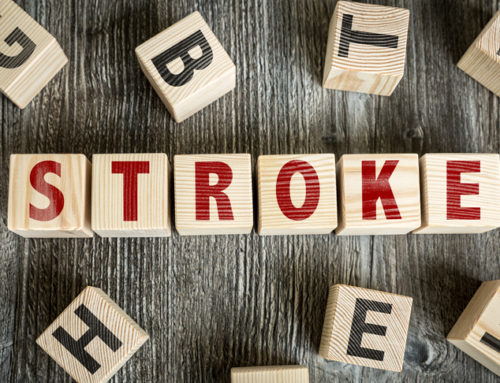The National Stroke Association tells us that one of the controllable risk factors for stroke is carotid artery disease. This also is known as carotid artery stenosis. The carotid arteries are the two major blood vessels in our necks that supply blood to the brain and head. Some of the things that can lead to carotid artery disease include:
- Age
- Unhealthy habits (poor eating, drinking heavily, obesity)
- Not managing stroke risk factors, such as high cholesterol
Plaque in the carotid arteries, which is usually caused by cholesterol deposits, can cause the narrowing, which can eventually cause total blockage of the arteries. A narrowed or blocked carotid can eventually lead to a stroke.
Symptoms
One of the biggest concerns with carotid artery disease is that there usually are no obvious symptoms. You may not be aware that you have the condition until you suffer a stroke or TIA. If you do feel any symptoms of a stroke or TIA, you should see a medical professional immediately. He or she can do tests on you to see if you have carotid artery disease.
Diagnosis
In many cases, this disease is detectable during a checkup with your doctor. He or she may order these tests:
- Physical exam/history: Your doctor can listen with a stethoscope for a rushing sound in the carotid artery, which is called a bruit. This will not always ID the disease. Some lower risk blockages can make the noise, but higher risk blockages may make no sound.
- Doppler ultrasound: This test will send sound waves above your hearing range into the neck. Echoes will bounce off of the blood and tissue in your artery and an image can be seen.
- Oculoplethysmography: This is a procedure that measures how much the arteries pulsate in the back of the eye. This is an indirect way to check for carotid artery disease.
- Computed tomography scan: This test gives a series of x-rays of the head and brain. It does not diagnose carotid artery disease, but it is useful to look into other stroke symptoms.
- Magnetic Resonance Angiography: This is much more accurate than ultrasound, but it does not have the risks that are related to x-rays and dye injection. It is a type of MRI scan that uses software to create an image in the arteries of the brain.
Treatment
This disease can be treated with medication, eating better and exercise, and surgery. In extreme cases, a surgeon can perform a carotid endarterectomy. This procedure will remove fatty deposits from the arteries. It can cut the risk of stroke by up to 55%.
Dressing Aids for Stroke Patients
Economy Hip Kits help you to dress and bathe and reach items more easily.
For people who have already had a stroke, there are many options available to help you to live a normal and productive life. Economy Hip Kits include several items that help you to perform daily tasks, such as bathing and getting dressed. The Button Aid and Zipper Pull helps you to deal with buttons and zippers if you have limited use of the hands.



